
Mythical and mystical. A land that has beckoned explorers and inspired writers, painters and artists. A rugged and breath-taking landscape of peaks, valleys, plateaus, and cliffs. A nation of proud and formidable warriors long ago, distinct from Tahitians, with their own language and culture. A people where a simple smile will win them over. The Marquesas Islands is a world unto itself.
The Marquesas Islands have been designated a UNESCO World Heritage Site since July 26, 2024, for their cultural and natural riches.
Located 1,500 km northeast of Tahiti, the Marquesas archipel ago consists of 12 islands, only 6 of which are inhabited. The Marquesas Islands emerge from the Pacific Ocean, high and lush. Nature is raw and its charm powerful. It is a land of stories and legends, as fascinating as it is unforgettable. Welcome to the Marquesas, the “Land of Men”.
Henua Enana should be the name one retains of the Marquesas. Each island of the archipelago is one of the foundation pillars of a divine house, built for mankind by Oatea and his wife Atanua.
The two large pillars are represented by the island of Ua Pou; the ridge beam by Hiva Oa; the other beams and rafters by Nuku Hiva; Fatu Hiva, representing the roof; and Tahuata the light at dawn; Mohotani, the song of a bird; and all the remains from the construction became the island of Ua Huka. After the era of the gods came the era of men. However, Spanish prowess, having launched its galleons all over the world as early as the 15th century, decided otherwise. Thus the name Marquesas was given by the Spanish explorer Alvaro de Mendana in 1595, while the four southern islands, observed or explored by sailors from the Spanish expedition, were given the names of saints: Santa Magdalena (Fatu Hiva), Santa Dominica (Hiva Oa), Santa Cristina (Tahuata) and San Pedro (the black rock of Mohotani). The Northern ones were given the honour by an American Joseph Ingraham, , in 1791, who renamed them: Ua Huka became Federal; Nuku Hiva, Washington and Ua Pou, Adams Island.
Posterity soon forgot those names which the Marquesans had always ignored. Meanwhile the Frenchman Etienne Marchand took possession of the archipelago in the name of France and its new regime. These now became the islands of the revolution. History takes a passing delight in these titbits, although only the name ‘Marquesas’ remains. From this administrative denomination, poetry took hold and finally we, the islanders, loved the gentleness of its name. But for you, visitors who wish to feel the history and emotional power of the Marquesas, remember this: these islands at the end of the world are called Henua Enana, the Land of Men.
According to Marquesan legend, the creation of the archipelago represents a house built by the god Oatea for his wife Atanua.
Located in the northern South Pacific Ocean, 1,500 km northeast of Tahiti, the Marquesas are one of the most remote archipelagos in the world. The Marquesas are spread over 12 islands (11 high islands and 1 atoll), of which only six are inhabited: Nuku Hiva, Ua Pou, Ua Huka, Tahuata, Hiva Oa and Fatu Hiva. Due to their geographical isolation, discovering the Marquesas Islands is a unique experience during a stay in Polynesia. The best way to get there, and sometimes the only way, is on board the Aranui, the essential link with the outside world for Marquesans. The Aranui will take you to some of the most remote villages in the world, which no other boat serves.Located in the North of the South Pacific Ocean, 1,500 km northeast of Tahiti, the Marquesas are one of the most remote archipelagos in the world. This volcanic archipelago is composed of 12 islands (11 high islands and 1 atoll), of which only six are inhabited: Nuku Hiva, Ua Pou, Ua Huka, Tahuata, Hiva Oa and Fatu Hiva. The largest island of the archipelago is Nuku Hiva and is inhabited by about 3000 people. The smallest uninhabited island is Motu Nui, which is only 0.36 km². The Marquesas Islands were discovered in 1595 by Álvaro de Mendaña y Neyra, a Spanish navigator. In 1842, the Marquesas Islands were annexed by France and are now part of French Polynesia. The Marquesas Islands are known as a natural paradise: here, no lagoon, but blocks of lava rising in the middle of the Pacific, streaked with deep green valleys. The Marquesas offer themselves in their authenticity and impose their difference. The Marquesas Archipelago is also known for its unique handicrafts, including tiki statues, wood or bone jewelry, carved pirogues and colorful weavings.
Due to their geographical isolation, discovering the Marquesas Islands is a special experience during a Polynesian holiday (cruise). The best way to get there, sometimes the only way, is on board the cargo ship Aranui, an essential link with the outside world for the Marquesans. The Aranui will take you to some of the most remote villages in the world on an unforgettable cruise, which no other boat serves.
Cooled by the gentle breezes of the South Pacific, the climate of French Polynesia is ideal. Being tropical but moderate, the days are sunny and pleasant, with an average yearly temperature of 27°C, making of French Polynesia a year-round destination. With a hot, humid season during the austral summer (November to April) and a cool, dry season (May to October), the breadth of the geography of French Polynesia means that each group of islands has a slightly different climate.
Being closer to the Equator, the Marquesas Islands have a warmer and wetter sub-tropical climate than of the Society Islands. In the Marquesas archipelago, the driest months are between August and December and the wettest months are March and April, although it is frequently sunny. The southern islands of the Marquesas are the wettest, while the northern islands are the driest. The best time to do a cruise in the Marquesas Islands is between May and December-January, when there is less rain. However, it should be noted that all year round is a good time to visit the Marquesas Islands with the Aranui, the experience being above all based on the discovery of the Marquesan culture and traditions.
The flora, originating from South-East Asia and South America, and the terrestrial fauna arrived in the Marquesas by the ocean, pushed by the winds or the Pacific swell. The Marquesas are characterised by a rich endemic flora, which its isolation has succeeded in preserving and conserving to 50%. The Ua Huka Arboretum protects rare or endangered species and is home to many varieties of Pacific trees. Due to its remote location, the archipelago’s terrestrial fauna is limited. Imported from Chile in the 19th century, horses, which Gauguin was so fond of depicting, are omnipresent on the island and often the only means of locomotion from valley to valley. On Ua Uka, often called the “horse island”, one can find wild horses as well as hundreds of goats. The bird, very important in traditional Marquesan society, has a few endemic species including the “pihiti”, found on Ua Huka, the “upe” on Nuku Hiva, and the “pahi” on Tahuata. Although increasingly threatened today, particularly by rats, the birds live rather serenely in the Marquesas.
Until recently, the island’s economic activity was mainly focused on agriculture (copra, lemons, grapefruits) and fishing, but it has gained new impetus, benefiting from the income from public works but also from the exploitation of the “noni”, a fruit with multiple virtues, which is increasingly popular internationally. At the same time, there has been a real boom in the craft and tourism sectors, boosted by the international reputation that its famous guests (Paul Gauguin, Hermann Melville, Jacques Brel) have shaped. Due to its geographical remoteness, maritime freight plays a key function in the economy of the archipelago. The Aranui plays an essential role in this respect, ensuring on the one hand the supply of food products, petroleum products and construction materials and on the other hand the export of local products to Tahiti. Cruises on board our mixed cargo ship are a unique opportunity to witness the unloading of cargo and to meet the local population.
In addition to traditional Polynesian dishes, such as Tahitian raw fish, “umu”, cooked for hours in a buried oven, the Marquesas have their own culinary specialities. These include curried goat, “popoi”, a fermented paste made from taro, a tuber grown on the island’s marshy lands. A staple food for Marquesans, the fruit of the breadfruit tree (“uru”) is eaten grilled over a wood fire, fried or baked, or fermented in silos in the Marquesas. This tree also plays a role in the history of Tahiti, since William Bligh was entrusted with the expedition of 1789, which gave rise to the famous Bounty mutiny, in order to acquire a few feet of this plant to acclimatise it in the British colonies.
In addition to French, the official language of French Polynesia, Marquesan is recognised as a French regional language. Distinct from Tahitian, and closer to Hawaiian, of which it is said to be one of the main ancestors, Marquesan is composed of two dialects: “eo enana”, spoken in the north-west of the archipelago, and “eo enata” spoken in the south-east. In 1977, in reaction to a decree imposing Tahitian as a compulsory language in all Polynesian schools, three courageous teachers from Ua Pou, supported by Bishop Hervé Le Cleac’h, set up the Motu Haka association to defend their language. And in 1985, the Marquesans were authorised to teach their language in primary school, which is an exception in all of Polynesia. After two centuries of prohibition, when Marquesans were never allowed to pray in their own language, we are now witnessing a cultural revival of Marquesan heritage, proud and happy to mark its difference.

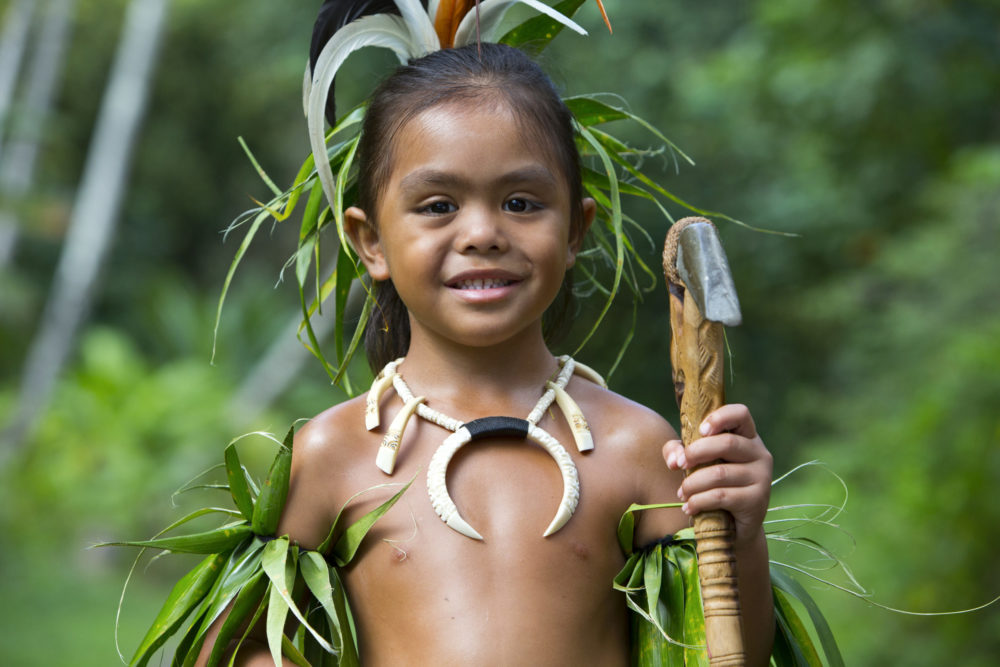
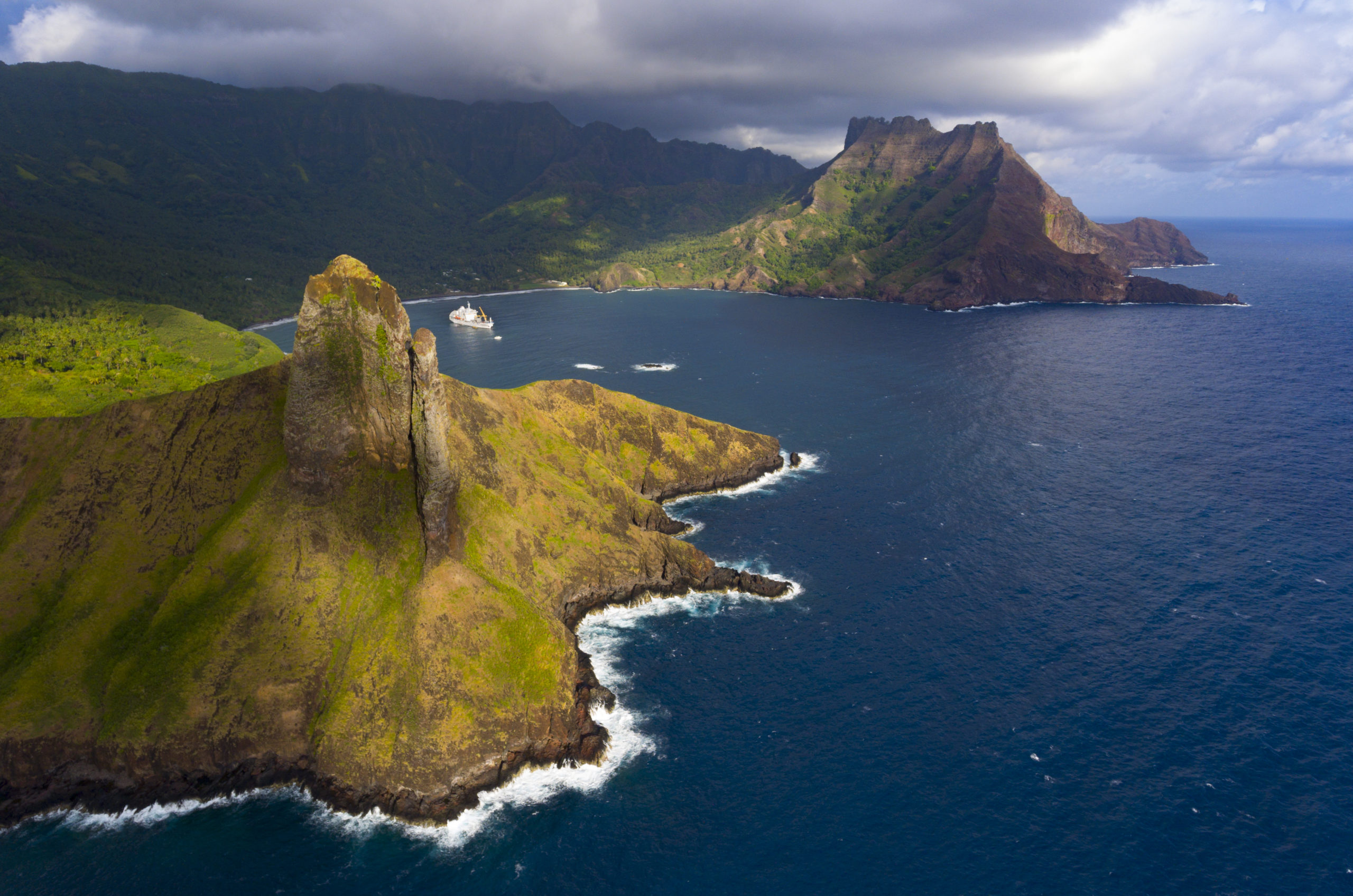
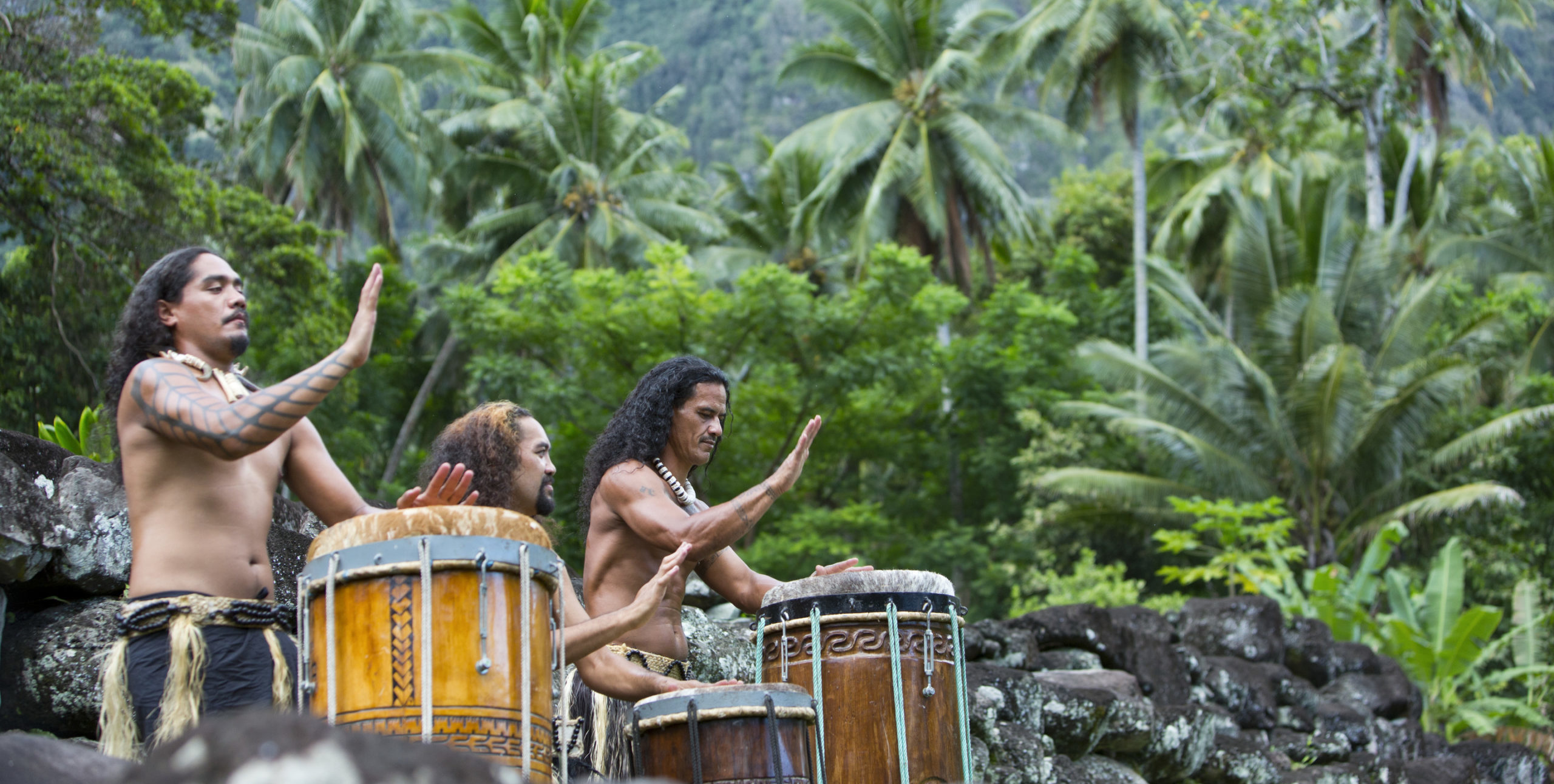
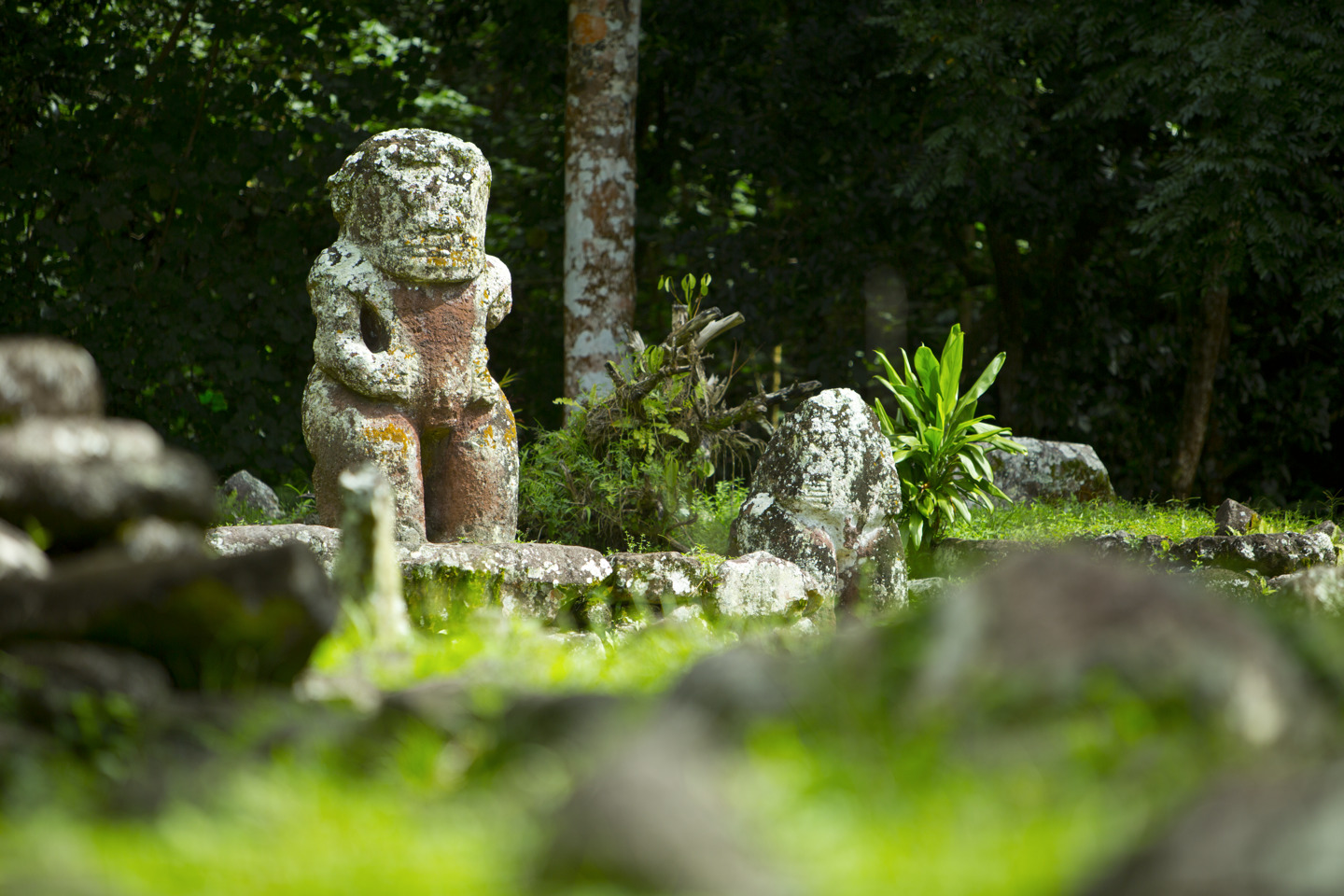
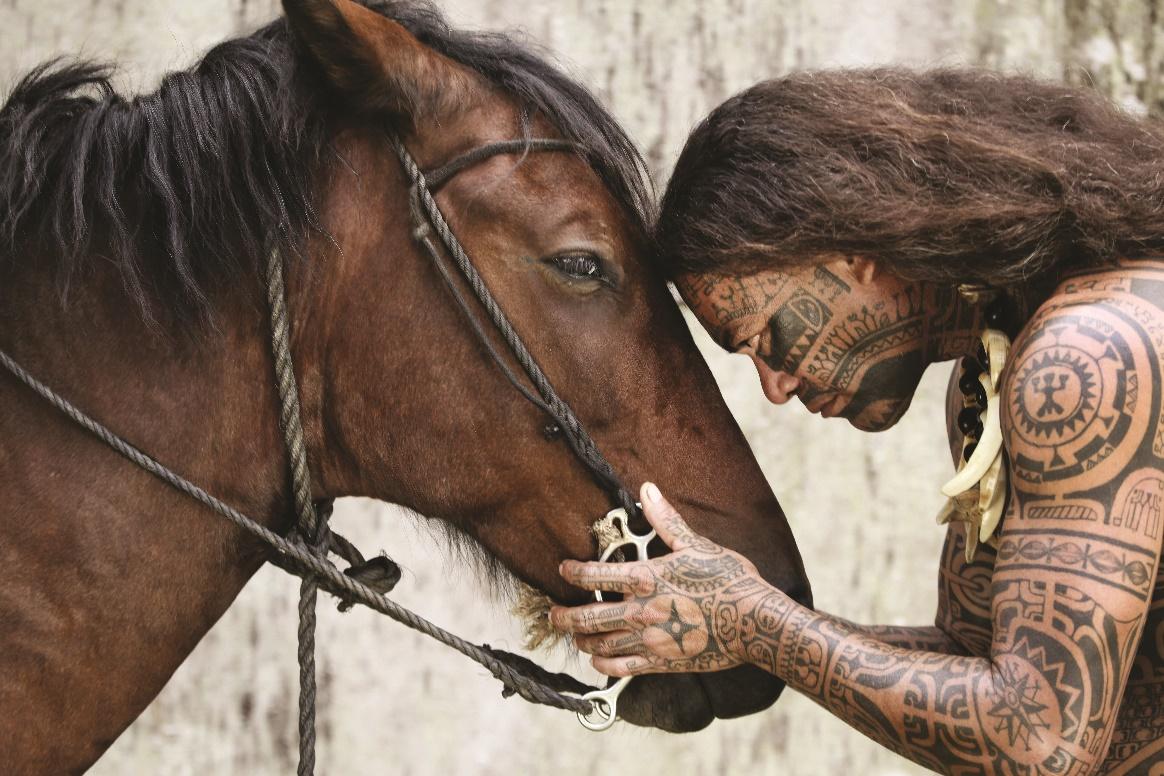
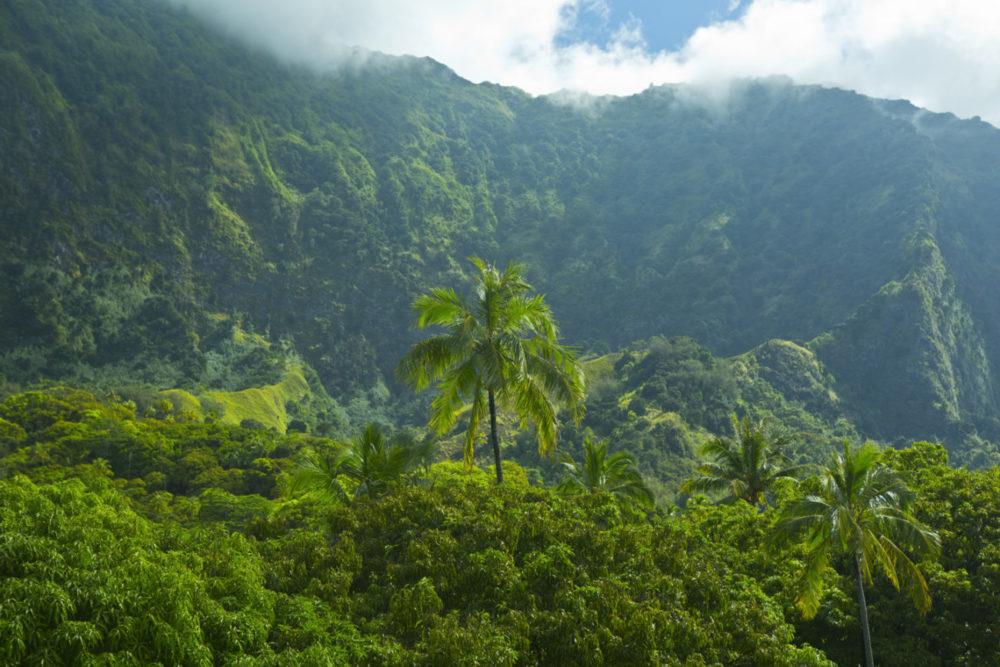
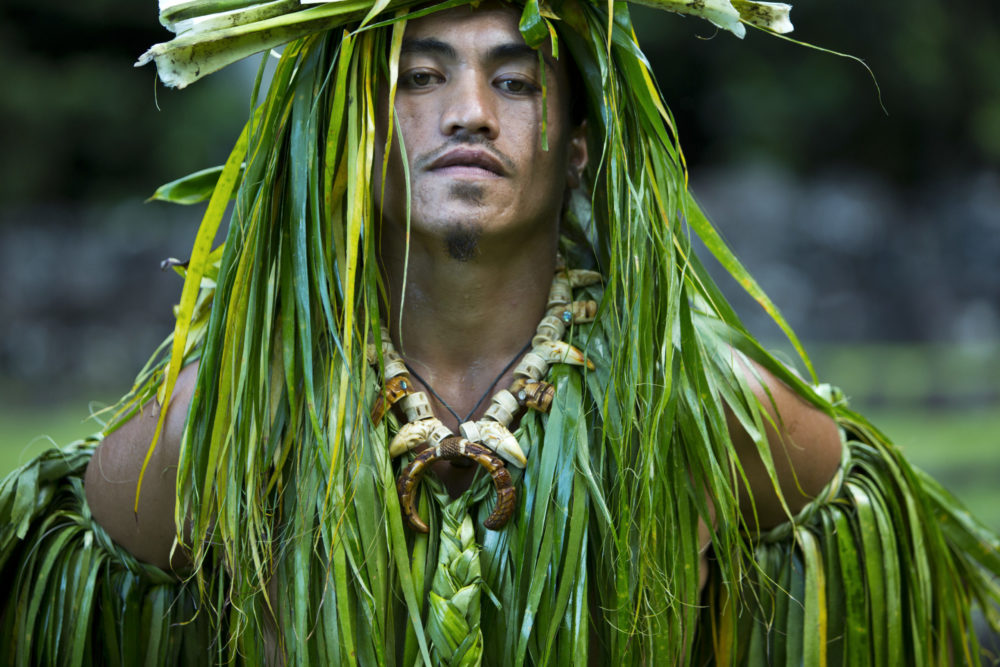
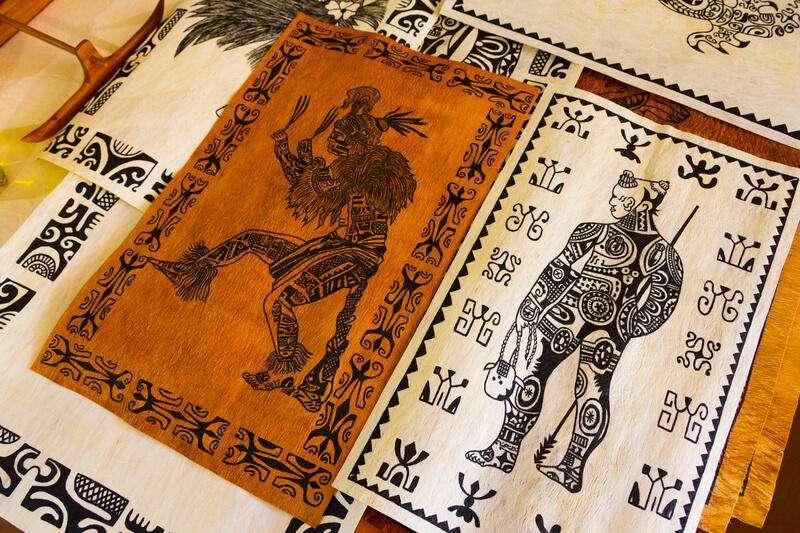
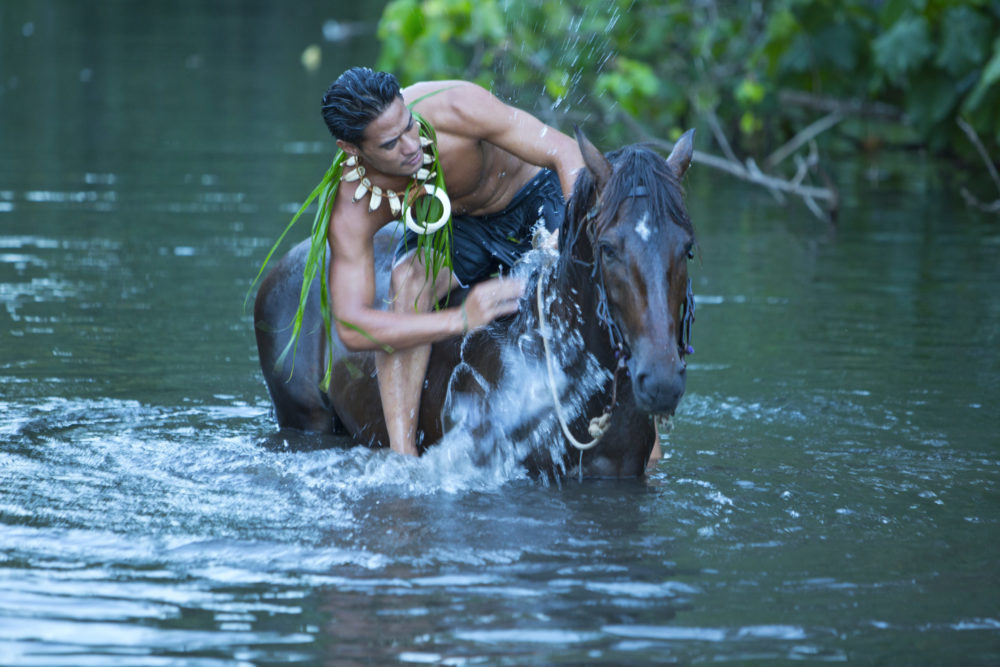
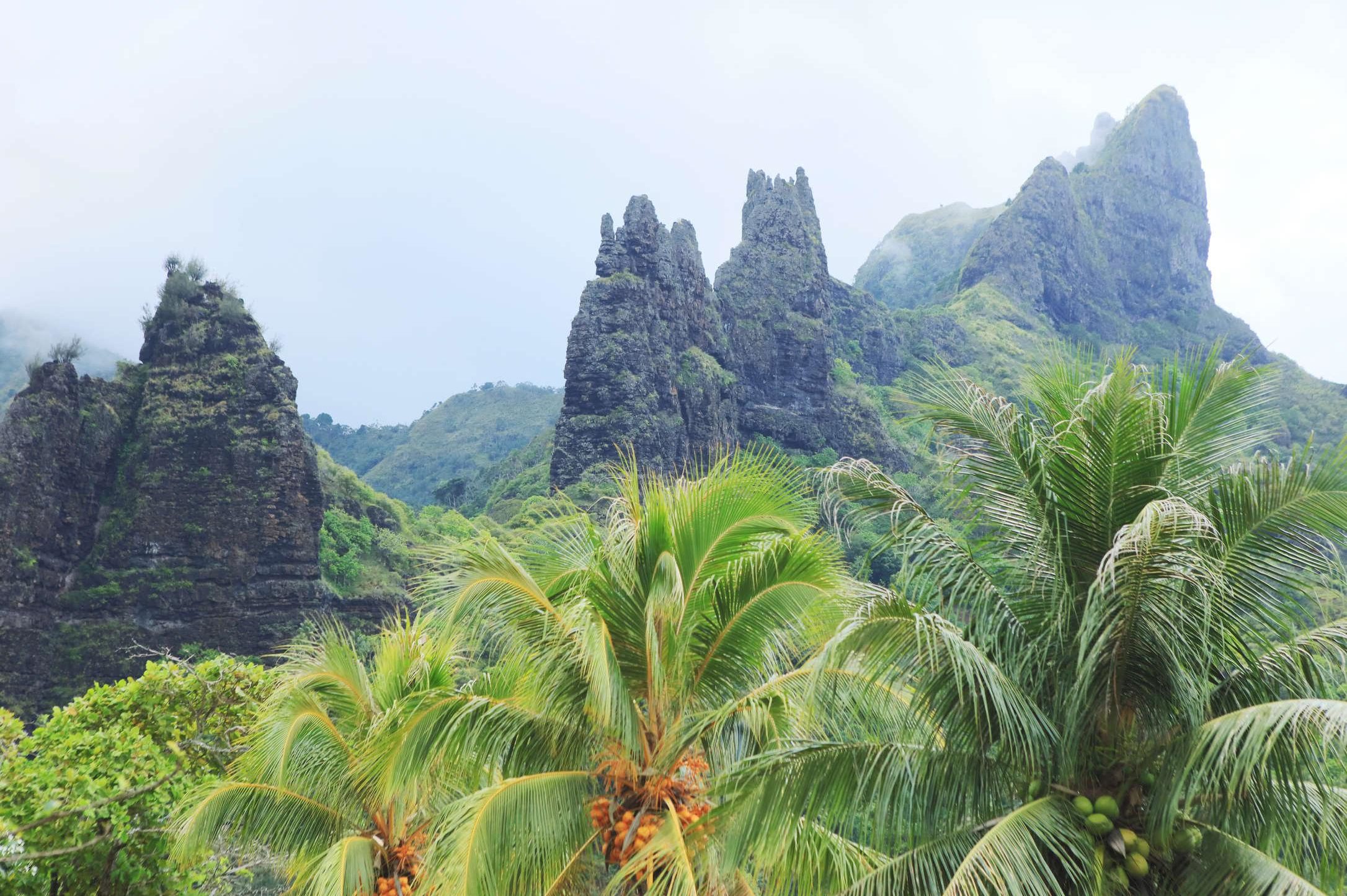
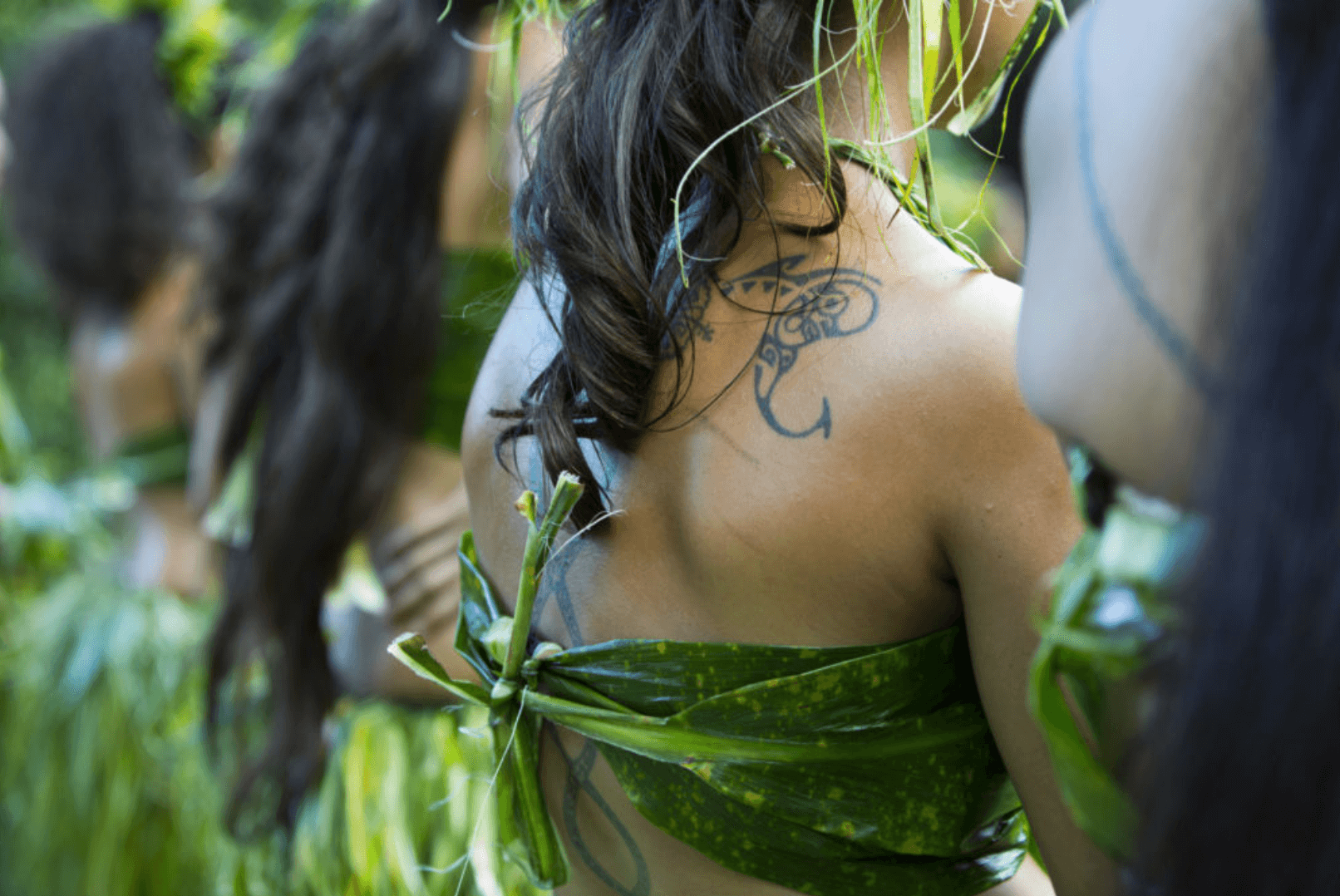
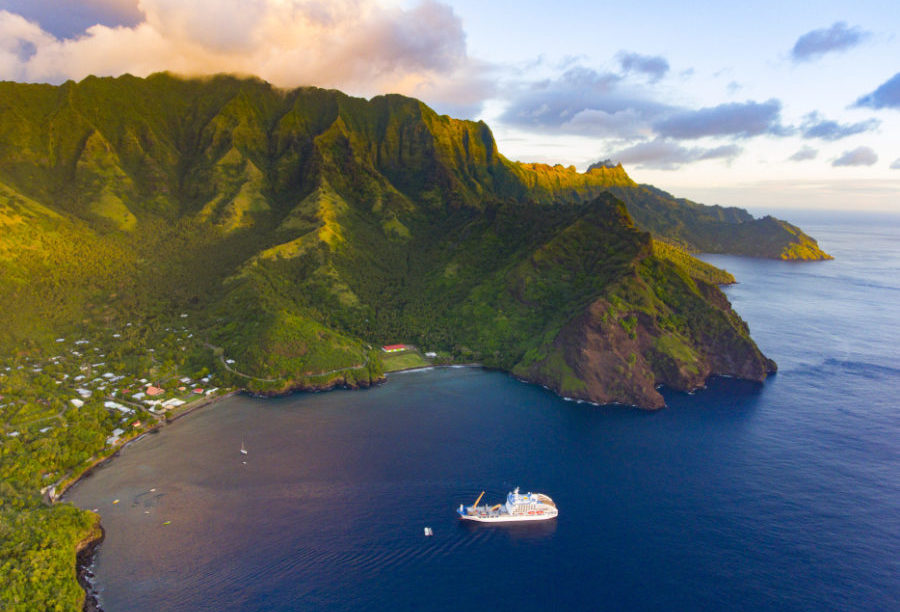


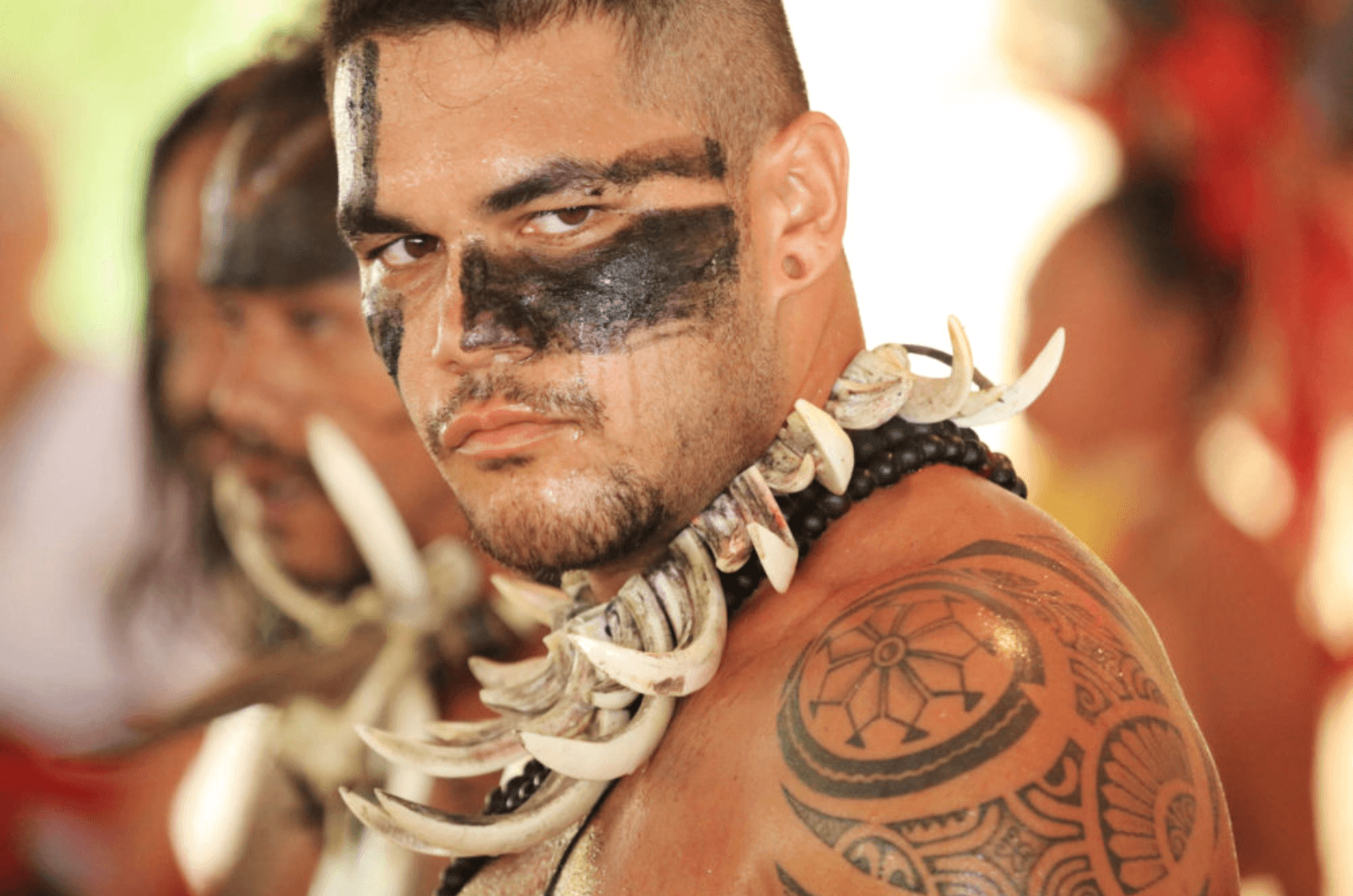

THE STOPOVERS OF OUR CRUISES INE THE MARQUESAS ISLANDS
During the cruise to the Marquesas Islands, Aranui 5 will call at each of the six inhabited islands of this mythical archipelago, where it will deliver the freight. While the crew unloads the goods needed by the islanders the passengers visit the islands with the ship’s English-speaking guides. While Aranui 5 offers several cruises in French Polynesia, this cruise to the Marquesas Islands remains it’s main and historic itinerary. As the main cargo carrier to the Marquesas, Aranui 5 has a vital link with this archipelago.
Hiva Oa, the island of artists
According to legend, Hiva Oa is the main beam of God’s “big house.” Today, it is commonly named the “Garden of the Marquesas” thanks to its fertile and lush land. The island features endless untouched nature: green, invading, and bright. Roads and houses are rarely seen. The island’s rugged landscapes blend sharp ridges, peaks and valleys scattered with archaeological sites and ruins, and is home to the largest tiki statues of French Polynesia. Hiva Oa is lined with black sand beaches and sharp cliffs diving in to the Pacific Ocean. The island’s main village, Atuona, is nestled at the end of Taaao Bay and overlooked by the highest mountains (Mount Temetiu – 4,186 ft. and Mount fe’ani – 3,366 ft.). This is also the place where two famous artists chose to live their lives: the French painter Paul Gauguin and the French poet, singer and actor Jacques Brel.
Fatu Hiva, the remote island
of the Marquesas
Fatu Hiva symbolizes the roof of Gods’ house: a small but stunning island. Arriving by sea, passengers are greeted by sheer landscapes and pristine vegetation. Fatu Hiva will mesmerize visitors. In 1937, Thor Heyerdahl and his wife, in their search for a genuine return to nature, set foot on the island to live as if at the dawn of the new world. Not much has changed. Today, most local people live around the village of Omoa where they make traditional and renowned tapa out of tree bark. The village of Hanavave is sheltered within an amazing bay: the Bay of the Virgins, probably one of the most beautiful bays on Earth, especially at dusk when the light illuminates the volcanic peaks turning the landscape into an unreal and unforgettable scene.
Ua Pou, mainstay of the Marquesas
Ua Pou symbolizes the entrance pillars to God’s house. Huge basaltic columns reach the sky and hold the names of legendary warriors: Poutetaunui and Poumaka. In 1888, they inspired poet Robert Louis Stevenson, who mentioned them as “volcanic arrows looking like a church bell tower.” They proudly overlook the bay of Hakahau village, the main village on the island.
Ua Huka, the horse island
Ua Huka symbolizes the “food basket” at God’s house and features more untouched beauty and is renowned for its dry soil and landscapes. Wild horses gallop as far as the eye can see around this desert-coloured land. Goats climb up on the island’s high plains. Peaceful and mystical, Ua Huka invites the traveller to discover a secluded universe, where the island’s ancestors are not just a part of the past but still very much part of the islander’s everyday life.
Nuku Hiva, the largest island
in the archipelago
If God had a “big house” symbolizing the Marquesas Islands, the largest of them – Nuku Hiva – would represent the top of the framework. The vertiginous volcanic peaks and amazing slopes blend with the blue of the Pacific Ocean. A special universe opens its doors. The starting point of your adventure is Taioha’e, the archipelago’s regional capital, opening at the end of a large bay holding the same name. Outstanding landscapes, an incredible archaeological history, great stories and a rich culture are all to be discovered alongside a friendly population.
Tahuata, the authentic Marquesas
Island
Tahuata symbolizes “sunrise” or “the enlightening home” at God’s house: a poetic image expressing reality so well. Small, Tahuata is only accessed by sea from Hiva Oa. The island offers charming discoveries to the privileged traveller. From its fertile valleys to its crystal-clear bays, Tahuata is an exquisite haven of peace, a place of history and creativity. Most inhabitants make a living out of their remarkable fine artwork, such as bone and rosewood – or miro (Thespesia populnea) carving. Mono’i is made following the scents of traditions and secrets, like an invitation to a mesmerizing perfume beautifully named “love potion” by the islanders.

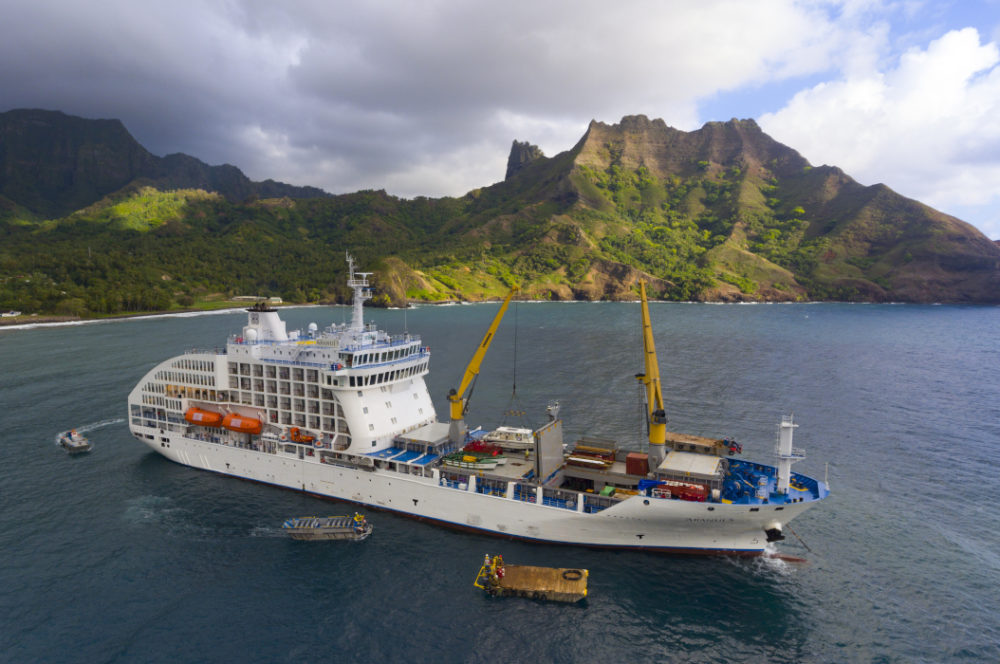
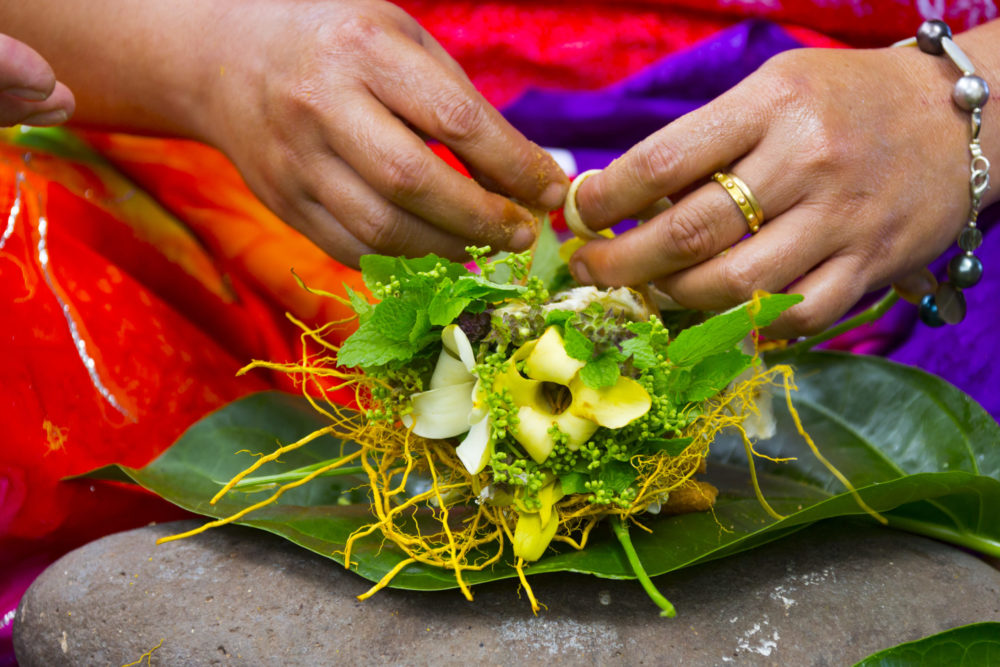
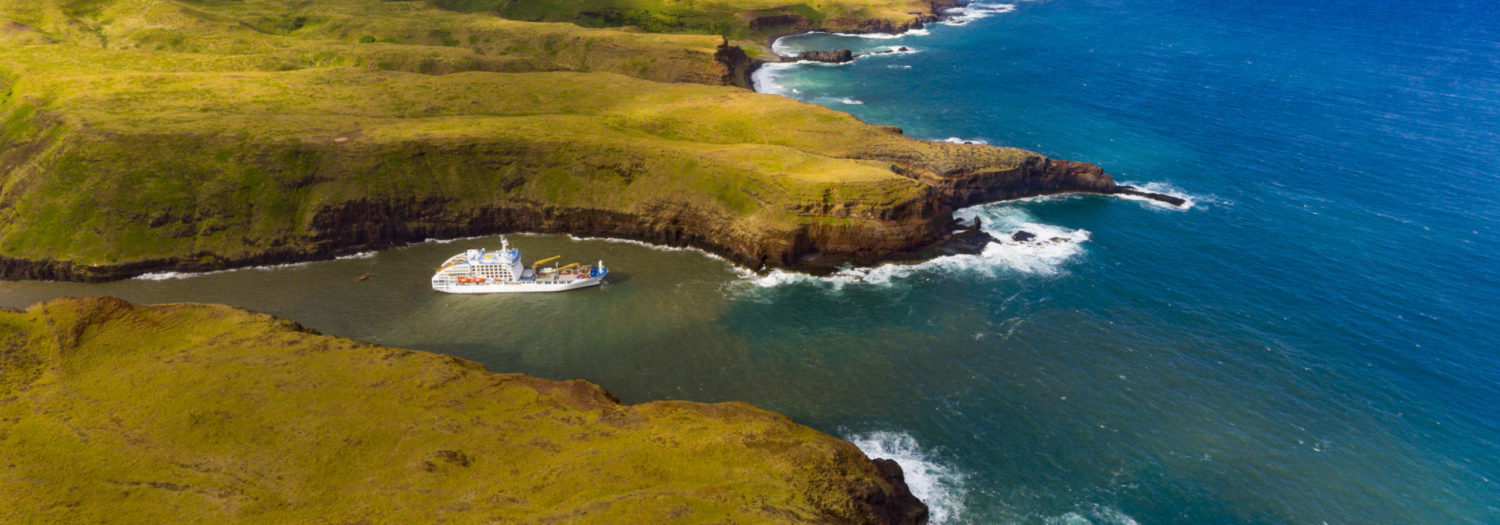
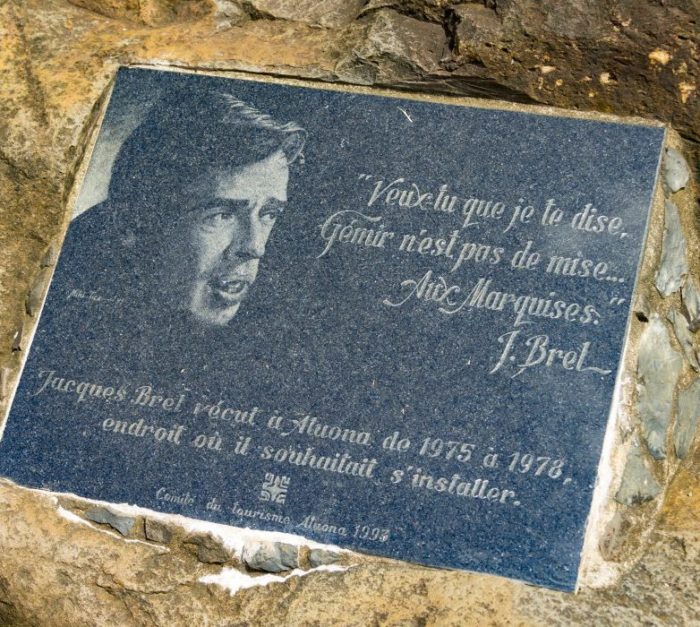
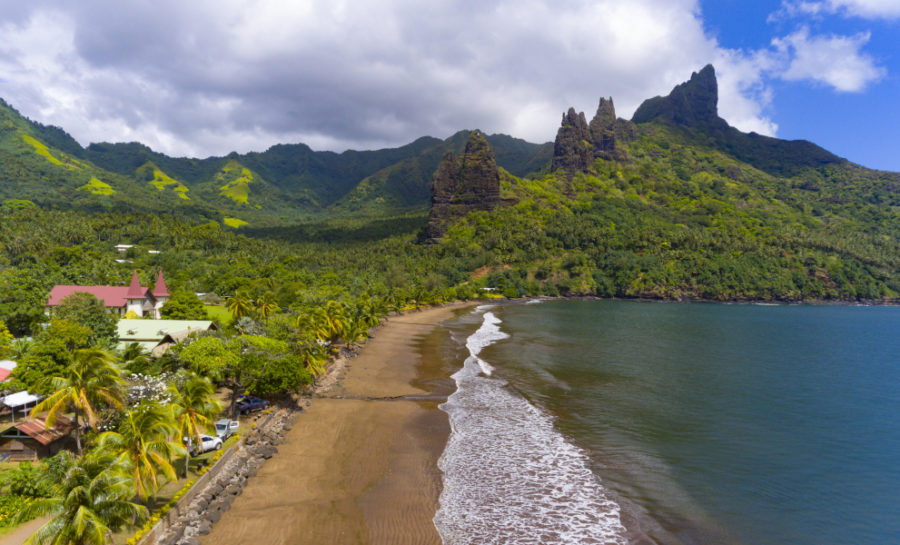
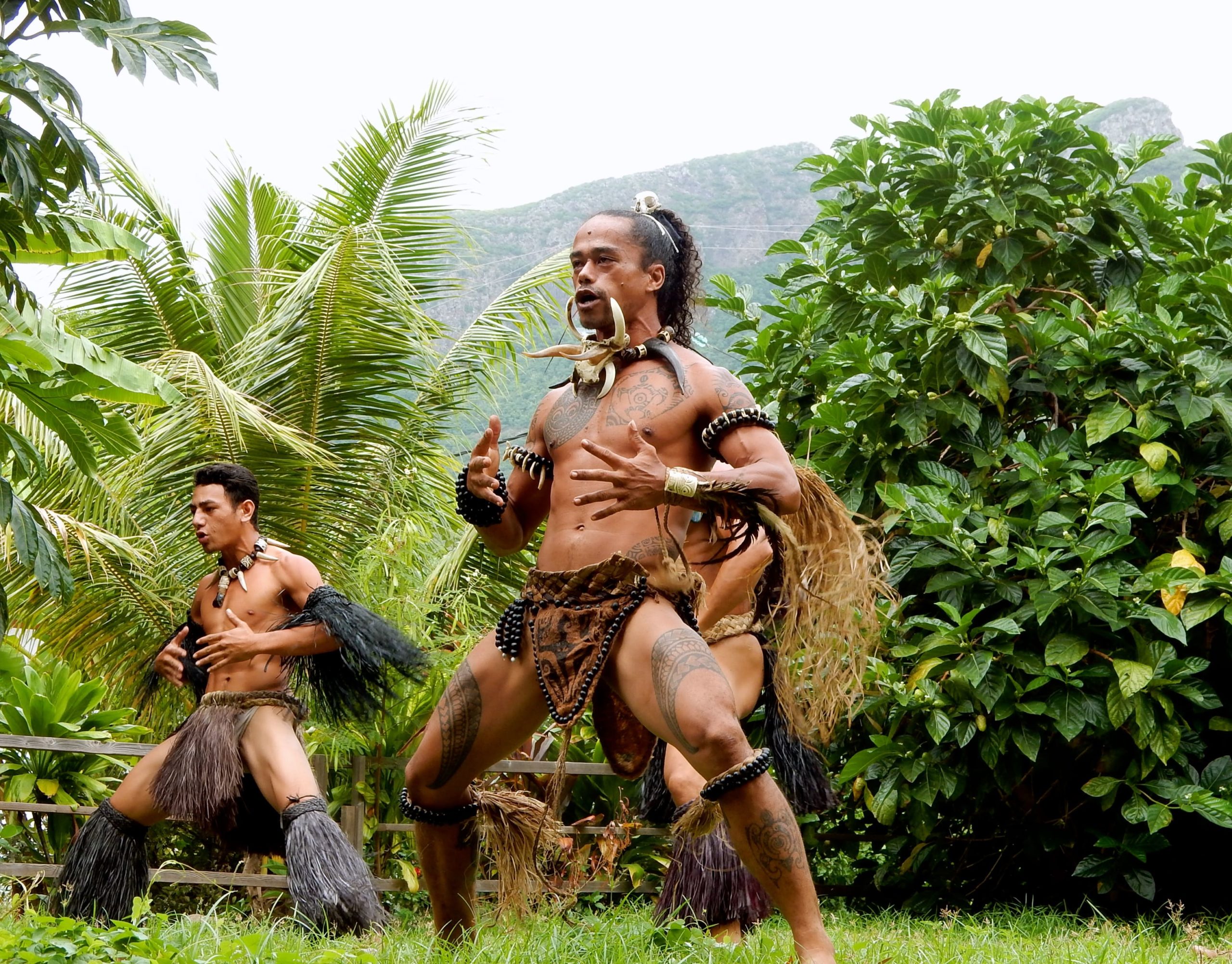
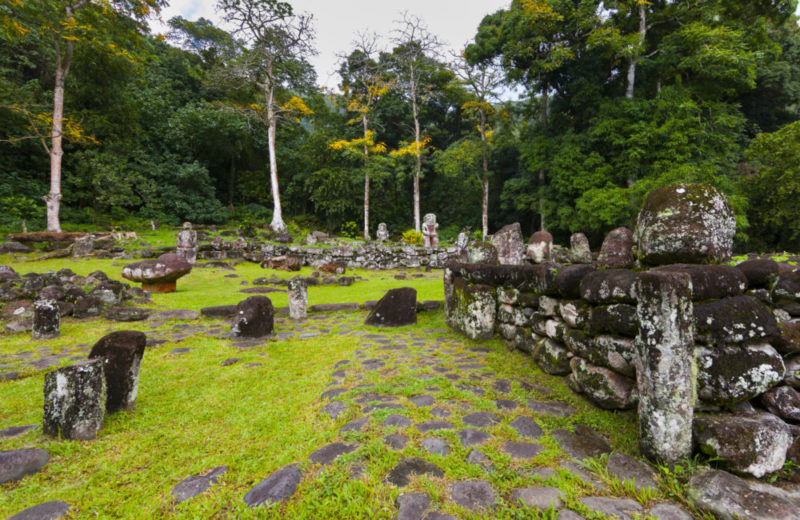
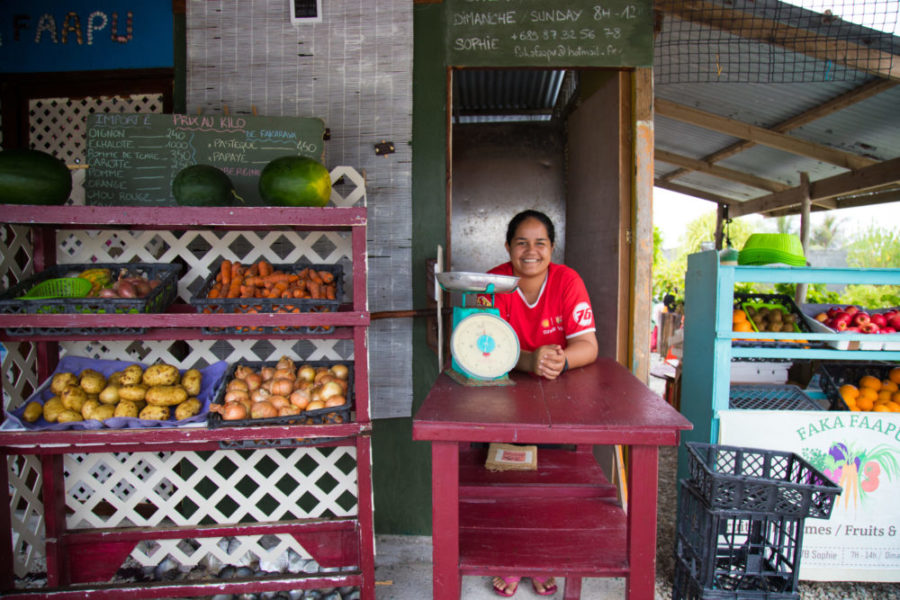
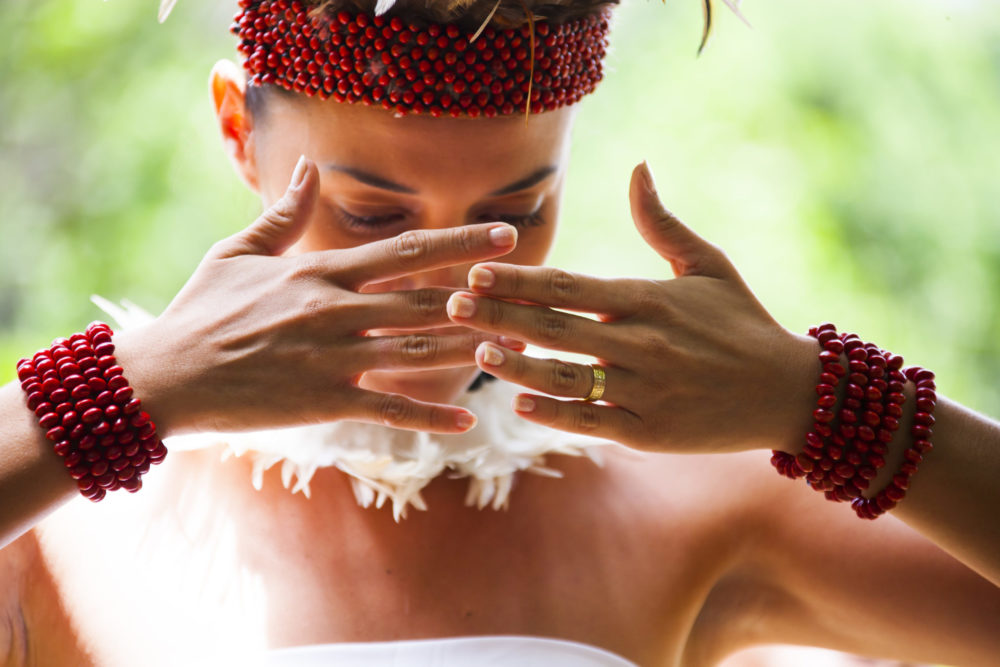
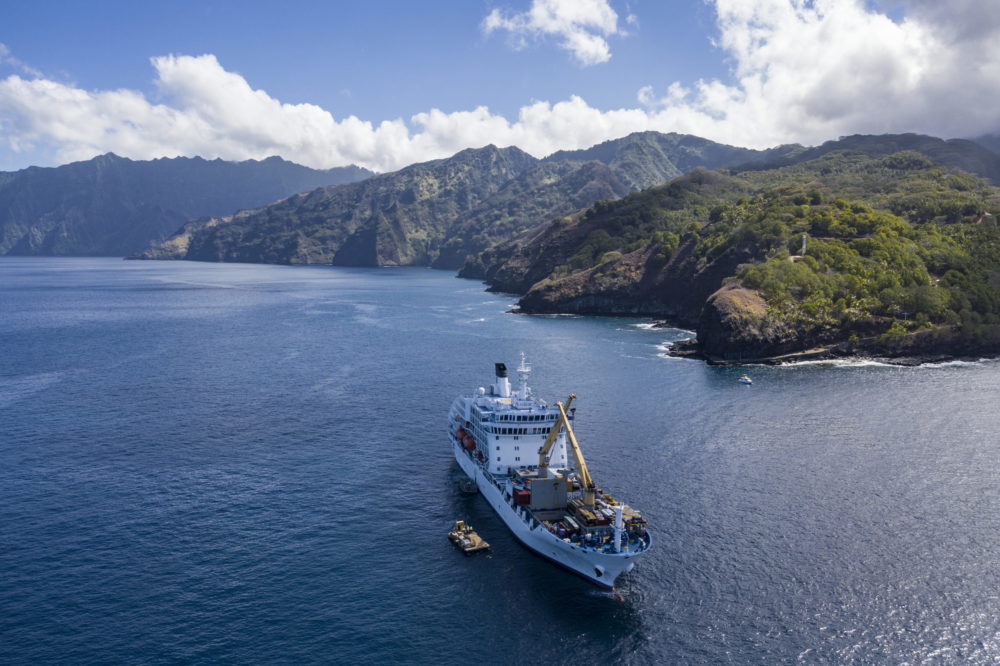
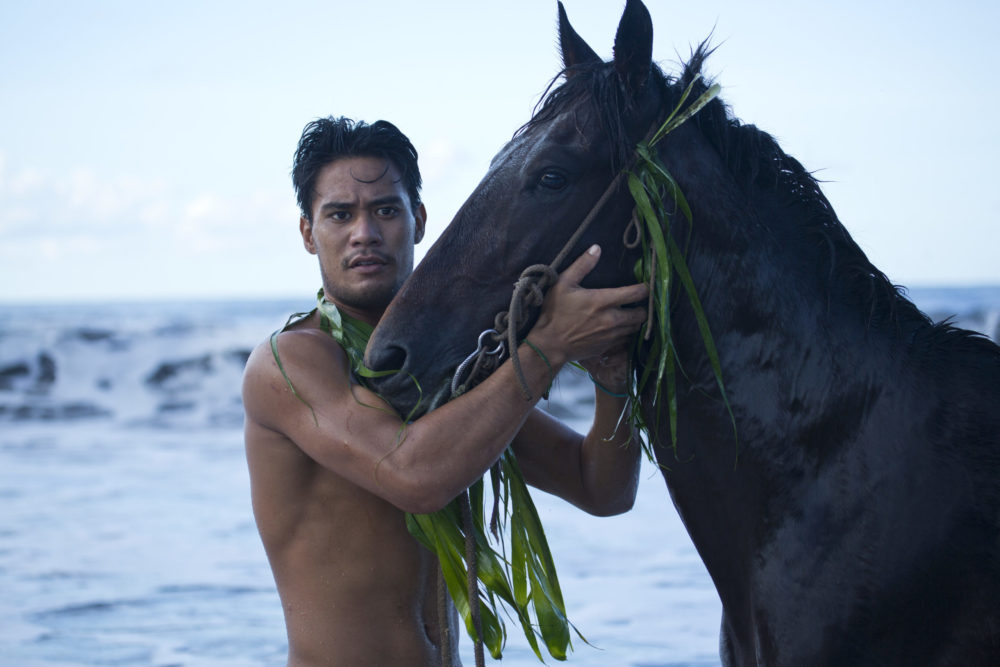
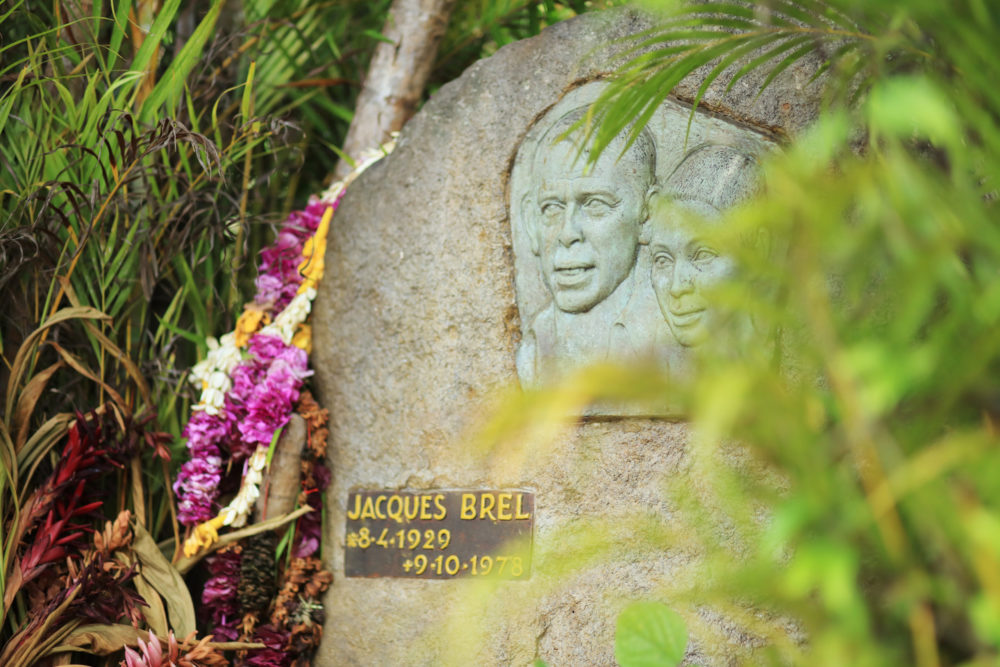

The Marquesas are one of those mysterious places, lost in the middle of the ocean, still relatively unknown to the general public. With rugged and breathtaking landscapes of mountains, valleys, plateaus, and cliffs, the Marquesas offer a world of their own. This is a land of proud and fierce ancient warriors, distinct from the Tahitians, with their own language and culture. The Marquesans are a people whose hearts are won with just a simple smile.
The Marquesas Islands are stunning in their beauty and rich in archaeological remains. This wild nature, home to wild horses and goats, combined with a strong and fascinating culture, made the Marquesas a welcoming land for great artists like Gauguin and Brel, who found here the raw emotions needed for their art. The northern group includes the large Nuku Hiva, 'Ua Pou with its sugarloaf mountains, and 'Ua Huka, the island of horses. The southern group includes Hiva 'Oa, the island of monumental tiki, Tahuata, and Fatu Hiva, the most isolated.
Each of the six inhabited islands of the Marquesas takes pride in its unique character and boasts a high-quality, creative traditional craftsmanship. Everywhere, tattooing is practiced and holds deep meaning, a legacy of a millennia-old culture. In the Marquesas, tattoos have reached an unprecedented level of artistry. Lastly, the hospitality of the Marquesan people is especially memorable.
It’s an ideal destination for travelers looking to experience a new culture and enjoy an unforgettable adventure aboard a ship unlike any other in the world. If you’re in search of an exotic and mythical destination, the Marquesas Islands are for you!
Taking a cruise to the Marquesas Islands aboard the Aranui is the best way to explore the six inhabited islands of the archipelago in all their splendor. The Aranui 5 is a mixed-use ship, providing both passenger transportation and supply services. It can accommodate up to 230 passengers in its 103 cabins on each journey, while also carrying up to 2,500 tons of cargo. Its route takes it through the Tuamotu Islands to the Marquesas before returning to Tahiti. In these remote islands, the Aranui is not just a cruise ship, but an essential link to the rest of Polynesia. As you enter the hidden bays of the Marquesas, you will feel it — the Aranui offers more than a cruise: it’s an adventure. Aranui in the Marquesas is an unforgettable, immersive experience, perfect for those seeking a true cultural immersion. As the Marquesas are still relatively unknown to the general public, the Aranui is the most original and authentic way to discover these islands before everyone else decides to visit!
The answer is yes! A cruise to the Marquesas Islands is an ideal vacation destination for families looking for an authentic, off-the-beaten-path journey, but in great comfort. The excursions offered during the Aranui cruise will introduce you to Marquesan culture through its villages, archaeological and historical sites, and artisans. Many activities are planned, including walks through magnificent natural sites, demonstrations of songs and dances, craftsmanship, 4x4 tours, snorkeling, and optional diving. The Aranui experience is thus very suitable for families with children, especially if the children are old enough to appreciate the discovery of another culture.
The cost of a cruise to the Marquesas Islands aboard the Aranui is estimated to be between €5,000 and €7,400 per person, depending on the type of cabin chosen, but can go as low as €3,200 in a dormitory. This budget includes accommodation and full board on the ship (with table wine, water, tea, and coffee), all scheduled excursions, and taxes. You should also plan to spend between €1,500 and €2,000 for round-trip international flights. On top of this budget, additional costs such as insurance, massages, onboard boutique purchases, optional excursions, or diving should also be factored in. The indicated price is an average, and may vary depending on factors such as the time of booking, the level of services chosen, etc.
The Marquesas are one of those mysterious places, lost in the middle of an ocean and still little known to the general public... Rugged and breathtaking landscapes of mountains, valleys, plateaus, and cliffs. A nation of proud and fierce ancient warriors, distinct from the Tahitians, with their own language and culture. A people whose hearts are won with just a simple smile. The Marquesas Islands are a world unto themselves.
The Marquesas Islands are stunningly beautiful and abound in archaeological remains. Wild nature, home to wild horses and goats, strong and fascinating culture, the Marquesas were also the home of great artists like Gauguin and Brel, who found there the raw emotions necessary for their art. The northern group includes the large Nuku Hiva, 'Ua Pou and its sugarloaf mountains, 'Ua Huka the island of horses; the southern group includes Hiva 'Oa, the island of monumental tiki, Tahuata, and Fatu Hiva, the most isolated.
Each of the six inhabited Marquesas Islands is proud of its uniqueness and flourishes in traditional and creative high-quality craftsmanship. Everywhere, tattooing is practiced and holds deep meaning, a heritage of a millennia-old culture. It has reached an unprecedented level of aesthetics in the Marquesas. Finally, the hospitality of the Marquesan people is particularly striking.
It is therefore an ideal destination for travelers looking to discover a new culture and enjoy a unique experience on a ship unlike any other in the world. If you are looking for an exotic and mythical destination, the Marquesas Islands are for you!
Taking a cruise to the Marquesas Islands aboard the Aranui is the best way to discover the 6 inhabited islands of the archipelago in all their splendor. The Aranui 5 is a mixed cargo and passenger ship. It can accommodate up to 230 passengers in its 103 cabins on each trip, while also carrying up to 2,500 tons of freight. Its route takes it through the Tuamotu Islands to the Marquesas, before returning to Tahiti. In these remote islands, it is not just a cruise ship, but an essential link with the rest of Polynesia. When you enter the hidden bays of the Marquesas, you will feel it — the Aranui offers much more than a cruise: it’s an adventure. The Aranui in the Marquesas is an absolutely striking and immersive experience, perfect for those seeking true cultural immersion. Mysterious islands still little known to the general public, the Aranui is the most original and authentic way to discover the Marquesas Islands before everyone else decides to visit!
The answer is yes! A cruise to the Marquesas Islands is a perfect vacation destination for families looking for an authentic and off-the-beaten-path journey but in the greatest comfort. The excursions offered during the cruise with the Aranui will allow you to discover the Marquesan culture through villages, archaeological and historical sites, and artisans. Many activities are planned, including walks through magnificent natural sites, demonstrations of songs and dances, craftsmanship, 4x4 tours, snorkeling, and even optional diving. The Aranui experience will be very suitable for families with children, especially if the children are old enough to appreciate discovering another culture.
The cost of a cruise to the Marquesas Islands aboard the Aranui is estimated at around €5,000 to €7,400 per person, depending on the type of cabin chosen, but can go down to less than €3,200 in a dormitory. This budget includes accommodation and full board on the ship (with table wine, water, tea, and coffee), all excursions scheduled in the program, and taxes. You should also add between €1,500 and €2,000 for round-trip international flights. On top of this budget, additional costs such as insurance, massages, onboard shop purchases, optional excursions or diving, etc., should also be considered. The price indicated is an average, and it can vary depending on factors such as the booking period, the level of services chosen, etc.

 Discover our cruises in the Marquesas
Discover our cruises in the Marquesas